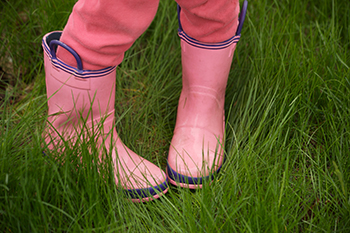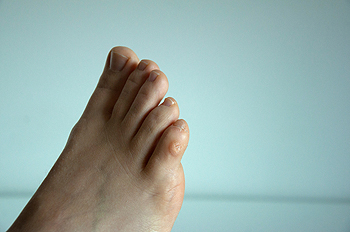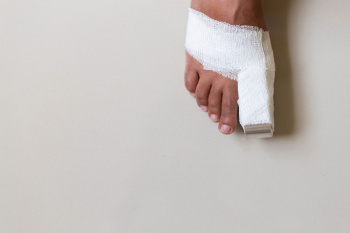Connect With Us
Blog
 In-toeing and out-toeing are gait abnormalities seen in children, where the feet point inward or outward, respectively, when walking. In-toeing, often called pigeon-toed, is usually caused by a slight rotation in the shinbone or thigh bone, or a curve in the foot. Out-toeing is less common and often occurs in older children. It can result from conditions like femoral retroversion, where the thigh bone is rotated outward, or from external tibial torsion, involving the outward rotation of the shinbone. Many cases of in-toeing and out-toeing resolve naturally as children grow and their musculoskeletal system matures. Treatment typically involves monitoring the child's growth and development rather than immediate intervention. However, in cases where the condition persists or causes significant walking difficulties, discomfort, or tripping, a podiatrist can offer treatment. It may include specific exercises, orthotics to correct foot positioning, or, in rare instances, surgical options to realign the bones. Regular podiatric check-ups ensure that the child's walking pattern is developing normally and any necessary adjustments are made to promote optimal gait mechanics. If your child is exhibiting abnormal gait patterns, it is suggested that you schedule an appointment with a podiatrist for evaluation.
In-toeing and out-toeing are gait abnormalities seen in children, where the feet point inward or outward, respectively, when walking. In-toeing, often called pigeon-toed, is usually caused by a slight rotation in the shinbone or thigh bone, or a curve in the foot. Out-toeing is less common and often occurs in older children. It can result from conditions like femoral retroversion, where the thigh bone is rotated outward, or from external tibial torsion, involving the outward rotation of the shinbone. Many cases of in-toeing and out-toeing resolve naturally as children grow and their musculoskeletal system matures. Treatment typically involves monitoring the child's growth and development rather than immediate intervention. However, in cases where the condition persists or causes significant walking difficulties, discomfort, or tripping, a podiatrist can offer treatment. It may include specific exercises, orthotics to correct foot positioning, or, in rare instances, surgical options to realign the bones. Regular podiatric check-ups ensure that the child's walking pattern is developing normally and any necessary adjustments are made to promote optimal gait mechanics. If your child is exhibiting abnormal gait patterns, it is suggested that you schedule an appointment with a podiatrist for evaluation.
Making sure that your children maintain good foot health is very important as they grow. If you have any questions, contact Carrie Frame, DPM of West Virginia Foot & Ankle. Our doctor can provide the care you need to keep you pain-free and on your feet.
Keeping Children's Feet Healthy
Having healthy feet during childhood can help prevent medical problems later in life, namely in the back and legs. As children grow, their feet require different types of care. Here are some things to consider...
Although babies do not walk yet, it is still very important to take care of their feet.
Avoid putting tight shoes or socks on his or her feet.
Allow the baby to stretch and kick his or her feet to feel comfortable.
As a toddler, kids are now on the move and begin to develop differently. At this age, toddlers are getting a feel for walking, so don’t be alarmed if your toddler is unsteady or ‘walks funny’.
As your child gets older, it is important to teach them how to take care of their feet.
Show them proper hygiene to prevent infections such as fungus.
Be watchful for any pain or injury.
Have all injuries checked by a doctor as soon as possible.
Comfortable, protective shoes should always be worn, especially at play.
If you have any questions please feel free to contact our office located in Charleston, WV . We offer the newest diagnostic and treatment technologies for all your foot and ankle needs.

Corns on the feet are small, yet bothersome, skin formations that can cause significant pain if left untreated. Foot corns, which are composed of layers of dead skin cells, typically appear as thick, circular, raised areas of skin. They commonly develop on, near, or between the toes, below the toenail bed, or on the sole of the feet. The three primary types of foot corns are hard corns, soft corns, and seed corns. Regardless of their type, foot corns can cause discomfort, pain, and a burning sensation, particularly when wearing shoes or walking barefoot. Foot corns develop from excessive pressure or friction on the foot. Causes include wearing tight or ill-fitting shoes, prolonged standing, and walking or running barefoot. It's a good idea to address foot corns promptly and effectively to prevent complications. A podiatrist can offer personalized treatment options, including professional corn removal techniques and recommendations for footwear modifications. If you are experiencing the discomfort of corns on the foot, it is suggested that you schedule an appointment with a podiatrist to determine the type of corn and its proper treatment.
Corns can make walking very painful and should be treated immediately. If you have questions regarding your feet and ankles, contact Carrie Frame, DPM of West Virginia Foot & Ankle. Our doctor will treat your foot and ankle needs.
Corns: What Are They? And How Do You Get Rid of Them?
Corns are thickened areas on the skin that can become painful. They are caused by excessive pressure and friction on the skin. Corns press into the deeper layers of the skin and are usually round in shape.
Ways to Prevent Corns
There are many ways to get rid of painful corns such as:
- Wearing properly fitting shoes that have been measured by a professional
- Wearing shoes that are not sharply pointed or have high heels
- Wearing only shoes that offer support
Treating Corns
Although most corns slowly disappear when the friction or pressure stops, this isn’t always the case. Consult with your podiatrist to determine the best treatment option for your case of corns.
If you have any questions please feel free to contact our office located in Charleston, WV . We offer the newest diagnostic and treatment technologies for all your foot and ankle needs.

A surgical procedure aimed at relieving pain from bone spurs on the top of the big toe is called a cheilectomy. The pain is the result of arthritis that also causes stiffness in the big toe, termed hallux rigidus. Typically considered after non-surgical interventions, a cheilectomy involves the careful removal of bone spurs to alleviate discomfort and improve range of motion. Whether performed under general or local anesthesia, the procedure usually allows for a same-day operation. Following surgery, treatment often starts with gentle toe movements and stretching exercises to prevent stiffness. The recovery period typically spans six to eight weeks. While individual recovery time may vary, the primary goal of restoring function and alleviating pain are the focus. If you have persistent pain and limited mobility in your big toe, it is suggested that you schedule an appointment with a podiatrist for an exam, diagnosis, and personalized treatment plan, which may include surgery.
Foot surgery is sometimes necessary to treat a foot ailment. To learn more, contact Carrie Frame, DPM of West Virginia Foot & Ankle. Our doctor will assist you with all of your foot and ankle needs.
When Is Surgery Necessary?
Foot and ankle surgery is generally reserved for cases in which less invasive, conservative procedures have failed to alleviate the problem. Some of the cases in which surgery may be necessary include:
- Removing foot deformities like bunions and bone spurs
- Severe arthritis that has caused bone issues
- Cosmetic reconstruction
What Types of Surgery Are There?
The type of surgery you receive will depend on the nature of the problem you have. Some of the possible surgeries include:
- Bunionectomy for painful bunions
- Surgical fusion for realignment of bones
- Neuropathy decompression surgery to treat nerve damage
Benefits of Surgery
Although surgery is usually a last resort, it can provide more complete pain relief compared to non-surgical methods and may allow you to finally resume full activity.
Surgical techniques have also become increasingly sophisticated. Techniques like endoscopic surgery allow for smaller incisions and faster recovery times.
If you have any questions please feel free to contact our office located in Charleston, WV . We offer the newest diagnostic and treatment technologies for all your foot and ankle needs.

